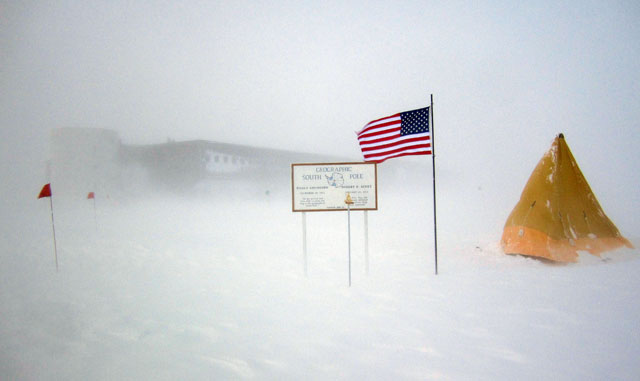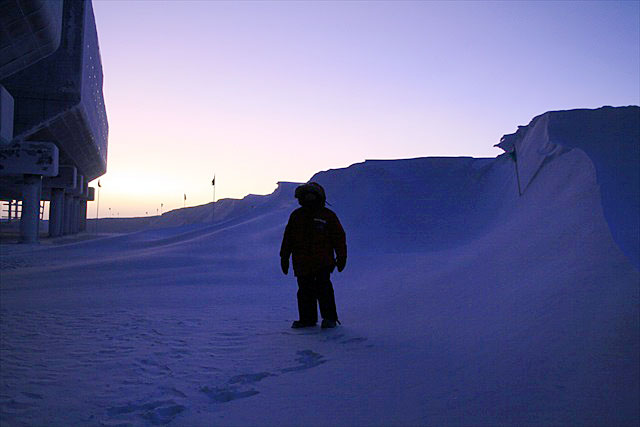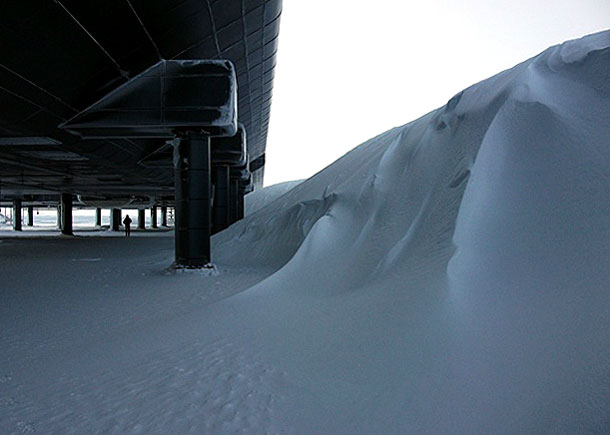|
Windy daysPole storms bring record-breaking gusts in SeptemberPosted October 14, 2011
The popular imagination usually conjures up a picture of the South Pole as a white, desolate place — bone-chillingly cold with gale-force winds that could knock over a building. The reality is that the geographic South Pole on the high polar plateau is not particularly windy, and the weather there doesn’t pack the sort of punch that rolls down to coastal areas where the U.S. Antarctic Program’s McMurdo Station But conditions converged that brought powerful storms to the South Pole Station Almost every peak and average wind record from Sept 21 to 27 was broken, culminating on the last day with the all-time strongest wind speed ever recorded at the South Pole. The peak wind speed was clocked at 58 miles per hour (mph), or 50 knots. The previous record of 55mph (48kts) was set on Aug. 24, 1989. South Pole meteorologist Tim Markle explained that the general circulation pattern shifted, with winds normally coming out of “grid east,” which keeps storm systems from penetrating into the interior of the continent, switching to “grid west,” allowing two powerful storm systems to push onto continent from the Amundsen and Bellingshausen seas. The storms from the west met a lingering but strong high-pressure system to the east in a meteorological scenario of an unstoppable force meeting an immovable object. Normally, when storms blow across Antarctica’s interior, they quickly weaken as they run into “very cold air and large topographic features, such as mountains, both helping to cut off the dynamic lifting needed to keep storms firing,” Markle explained. “So what we had was strong high pressure to our grid east and strong low pressure to our grid west, with neither wanting to budge. This set up a strong, or tight, pressure gradient directly over the South Pole, [which] signifies an increase in the wind. The windy weather persisted over the South Pole until the dynamic support for the storm systems waned and both storms weakened,” Markle explained. Winter boasts the stormiest months, with the strongest winds at that time of the year, he said. Climatologically, August is the windiest month, with an average monthly wind speed of 13.7mph (11.9kts). However, all months from May through October have an average wind speed above 13mph (11.3kts). The storm came with less than a month before the station is scheduled to receive its first relief flight of the summer field season on Oct. 17, creating a lot of extra work for personnel to unbury buildings. “I would say that we received about an entire winter’s worth of drifting in a one-week period,” said Markle, who has wintered over at the South Pole for three seasons. “Many low-lying buildings and buildings directly on the snow surface now have large drifts both upwind and downwind of them.” The Records
The late spring storms at the South Pole raged from Sept. 21 to 27. Almost every peak and average wind speed record was broken over that period. Click here to see a list of the new records.
The weather briefly turned milder after the storm, with temperatures approaching minus 30 degrees Fahrenheit. “Therefore, we have had the good fortune and ability to utilize almost all of our available vehicles to get folks outside and speed up the station opening tasking,” Markle said, adding that support personnel are back on schedule for the Oct. 17 arrival of a Basler aircraft. “Obviously, with all this work being done outside in order to prepare for station opening, we are keeping our fingers crossed for no more windy weather,” he added. Interestingly, until the September storm, the winter had not been very windy. The average monthly wind speed was lower than the climatological norm for every month except for September. Peak wind gusts for the other winter months ranged between 26 mph and 32 mph, Markle said. Another winter record of note: May 2011 was the coldest May on record, with an average monthly temperature of minus 80.7F (minus 62.6C). That broke the previous record of minus 80.1F (minus 62.3C) set in 1989. The only day to drop below minus 100F during the 2011 winter also occurred in May on the 27th, with the mercury bottoming out at minus 103.4F (minus 75.2C). |



For USAP Participants |
For The Public |
For Researchers and EducatorsContact UsU.S. National Science FoundationOffice of Polar Programs Geosciences Directorate 2415 Eisenhower Avenue, Suite W7100 Alexandria, VA 22314 Sign up for the NSF Office of Polar Programs newsletter and events. Feedback Form |




